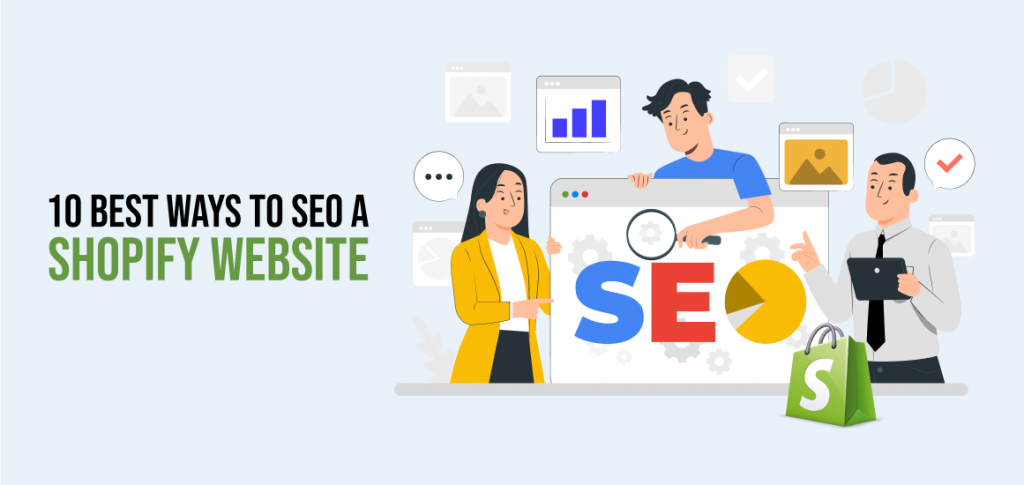Contents
Optimizing your Ecommerce Store, blog, or website? These Shopify SEO tips cover all important elements that help boost Shopify online sales with SEO. (Italics)
When you want to build the digital presence of your retail business, or launch a new product, or start a dropshipping venture; the biggest hurdle in front of you is how to attract customers to your store.
The catch is ensuring that potential buyers searching for products similar to yours are able to discover your Shopify store easily.
What to do now?
Well, leveraging SEO is an effective way to enhance your store visibility in SERP results. It makes it easier for potential customers to find what you offer.
By hitting the Shopify SEO for ecommerce in the right way you increase the likelihood to attract genuine visitors who are interested in purchasing i.e. you drive organic traffic and boost Shopify online sales with SEO.
Therefore, we are sharing some of the best practices suggested by Shopify SEO experts on how to do Shopify SEO for ecommerce. To boost your sales and grow your business consider these Shopify SEO tips when optimizing your website.
10 Best Ways to SEO a Shopify Website

Well-Organized Store structure
For a good user experience and optimization for search engines it is essential to have a logical structure of your website. It must be easy for visitors to navigate through your store, follow logical hierarchy for different categories. A well organised store structure helps search engines to crawl your website effectively thus allowing them to index your content more accurately.
You are blessed, if your store is on Shopify. It is easy to sell there as Shopify has built-in search engine optimization that ensures all of your content is easily found by search engines. The platform automatically follows a logical hierarchy of categories in terms of content added. It ensures that pages don’t use Iframes and URLs use standard characters and a simple, readable structure.
However, you can still do a few things on your own to optimize your website structure for search engines, such as optimizing store menus, giving descriptive file names for your images and using descriptive texts for internal links.
Well Optimized Pages (category and product pages)
The best Shopify SEO for dropshipping or ecommerce business says that it is essential to have unique and descriptive Titles and meta descriptions for all the content. Include relevant keywords, write clear readable and well optimized URL slugs for example (https://www.example.com/collections/women-handbags). Try to incorporate keywords naturally to all your content ensuring that they add to the valuable information you have for your potential customers.
Set up the essentials
The advanced SEO techniques demands all fundamental elements to be in the right place. The foundational elements covers –
- Having a custom domain – having a unique domain enhances the potential of Brand as well as the Shopify SEO for dropshipping or any ecommerce business. Rather than relying on myshopify.com, the default subdomain, it is advised to purchase a custom domain. It helps to avoid content duplication issues that can dilute your SHopify SEO efforts.
- Setting up an Analytics account – second essential task to do Shopify SEO for ecommerce is installing and setting up Google analytics accounts. This assists in tracking website traffic and analyzing user behaviour. The data traced through the analytics account is invaluable and assists Shopify SEO experts to make informed decisions regarding marketing strategies.
- Setting up Google Search Console – Setting up search console is crucial as it lets you monitor store performance in search engine result page, identify the issues so that you can optimize your content accordingly.
Work on Your Site Speed
The most essential strategy followed by experts while giving Shopify SEO services is improving website speed. These are critical for Shopify website SEO ranking as well as for user satisfaction. Brands must know the performance of their website, analyze and identify the areas of improvement. For this, tools like Google PageSpeed comes handy. To increase your website speed compress the images used, leverage browser caching and most important is to reduce the number of applications running on your site.
Conducting Keyword Research
The basic fundamental for an effective Shopify SEO is finding the right keywords. Tools like SEMrush, Ubersiggest, Ahrefs and google keyword planner helps to identify that are relevant to your product and industries and the keywords that your potential customers are searching for. Create new pages targeting specific terms and use the keywords in your content including titles, meta descriptions and map the keywords to existing pages. Try focusing on long-tail keywords to focus on user intent.
Work on Quality Content
Content is the king in the SEO world. Shopify SEO expert says that to boost Shopify online sales with SEO, creating quality content is the main and major. Publishing high-quality blog posts on a regular basis related to your product or industry, addressing common questions or work on topics that potential customers are searching for provides value to your audience. The published content helps to establish your authority in the market and also attract inbound links from other websites. Similarly you can try adding product video reviews, it helps to boost engagement with customers and provide additional information about your offerings.
On-page Optimization
On identifying the relevant keywords and having worked on quality content, implement the keywords effectively on your website. Here are three main ways –
- Optimize meta title and meta descriptions for all of your product page or category pages including primary keywords everywhere.
- Instead of the manufacturer-provided content for product and category description, write a unique one for your store to improve relevance and avoid duplicate content penalty.
- Images play an important role and need to be optimized for Shopify SEO. Use descriptive file names and alt texts for all the images on your website. This improves visibility in image search results. Also try incorporating relevant keywords apt. It helps in accessibility and allows search engines to understand what the image depicts. Compressing image size proves beneficial in enhancing load time and affecting ranks on SERP.
- Building internal as well as external links – Link building is essential to boost Shopify online sales with SEO. To keep users engaged with your content for a longer period of time and to redirect them to related content internal linking is crucial. It assists search engines to understand the structure of your site. Similarly, use different tools like Ahrefs to identify sites linking to competitors and work on external backlinks. Collaborate with influencers or do guest posting on relevant blogs within your industries to provide value to the audience while earning external backlinks. You can also create linkable assets such as infographics or original research that others may want to refer to, this helps to increase your site’s authority.
Use structured Data
Implementing schema markup also called structured data can enhance how your product or content appears on search engines. Using schema markup on product pages lead to rich snippets that help to provide additional information such as (prices, availability, and ratings) directly in the search result thus improving click through rates.
Mobile Responsive Design
Google’s priority to mobile first indexing makes it important for all ecommerce stores to optimize their website for mobile devices. Responsive themes adjust to various screen sizes seamlessly be it mobile, laptop, desktop or tabs and tests websites mobile performance on a regular basis to ensure smooth user experience. You can try Shopify theme ‘Dawn’ the best responsive theme automatically adjust to varied screens.
Leverage Analytics tools to monitor performance
Remember we told you to set up Google analytics and google search console for your store. Those will be used now, to track your sites performance, understand user behaviour, and analyze keyword performance to refine your Shopify SEO strategies based on real time data. With these analytics tools you can monitor site performance based on key metrics such as real time organic traffic, conversion rates, bounce rates and more. Continuously test different strategies, optimize store performance based on real time data and stay up to date with changing SEO trends.
Towards the end…Shopify SEO for Ecommerce
Implementing Shopify SEO for dropshipping or ecommerce businesses have many facets. By focusing on the best practices outlined in this article such as technical optimization, generating quality content, creating backlinks, having well organized site structure can help improve your store’s visibility in search engines.
Ecommerce stores are required to optimize their site and monitor performance constantly in order to attract more organic traffic and boost Shopify online sales with SEO.
As the e-commerce landscape becomes increasingly competitive, the Shopify SEO tips stated in here can not be overlooked. Following these religiously have a significant impact on user experience and your websites ranking on search pages.
Shopify SEO Services leverages these techniques to attract potential customers, foster long term growth and success and positions your business to thrive in the digital marketplace. To boost Shopify online sales with SEO, start your store optimization today and see the result for yourself!








